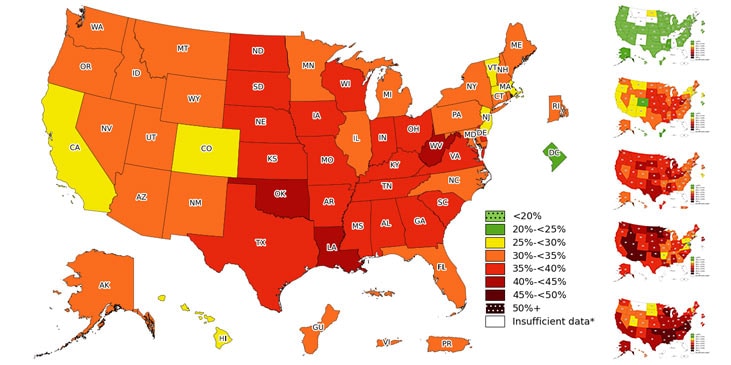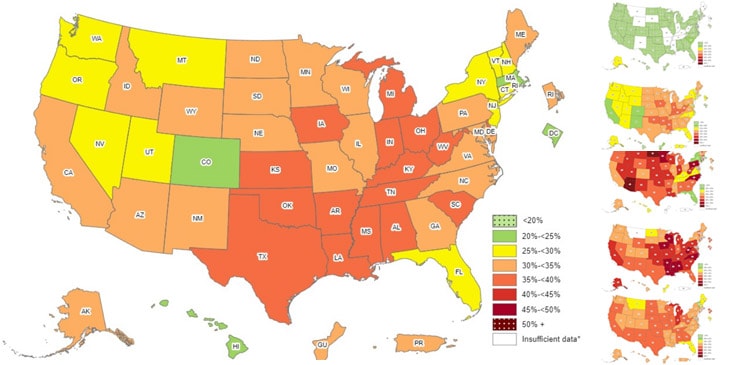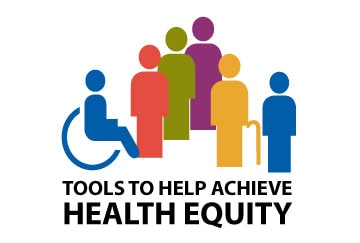Adult Obesity Prevalence Maps
Media Statement | What Can Be Done | Updated Sept 21, 2023
The CDC 2022 Adult Obesity Prevalence Maps for 50 states, the District of Columbia, and 3 US territories show the proportion of adults with a body mass index (BMI) equal to or greater than 30 ( ≥30 kg/m2) based on self-reported weight and height. Data are presented by race, ethnicity, and location. The data come from the Behavioral Risk Factor Surveillance System, an ongoing state-based, telephone interview survey conducted by CDC and state health departments.
The 2022 maps show that obesity impacts some groups more than others. There are notable differences by race and ethnicity, as shown by combined data from 2020–2022.
Among geographic groups (states, territories, or DC) with enough data, the number with an adult obesity prevalence of 35% or higher, by race/ethnicity, is:
- Non-Hispanic Asian adults: 0 (among 37 states, 1 territory, and DC)
- Non-Hispanic White adults: 14 (among 49 states, 1 territory, and DC)
- Hispanic adults: 32 (among 49 states, 2 territories, and DC)
See CDC PLACES for community-level data.
- Non-Hispanic American Indian or Alaska Native adults: 33 (among 47 states)
- Non-Hispanic Blacks: 38 (among 48 states and DC)
By Education and Age
- Obesity prevalence decreased as level of education increased. Adults without a high school diploma or equivalent had the highest prevalence of obesity (37.6%), followed by adults with some college education (35.9%) or high school graduates (35.7%), and then by college graduates (27.2%).
- Young adults were half as likely to have obesity as middle-aged adults. Adults aged 18–24 had the lowest prevalence of obesity (20.5%) compared to adults aged 45–54, who had the highest prevalence (39.9%).
Across States and Territories
- All states and territories had an obesity prevalence higher than 20% (more than 1 in 5 adults).
- The District of Columbia had an obesity prevalence between 20% and less than 25%.
- 6 states had an obesity prevalence between 25% and less than 30%.
- 22 states, Guam, Puerto Rico, and the Virgin Islands had an obesity prevalence between 30% and less than 35%.
- 19 states had an obesity prevalence between 35% and less than 40%.
- 3 states (Louisiana, Oklahoma, and West Virginia) had an obesity prevalence of 40% or greater.
- The Midwest (35.8%) and South (35.6%) had the highest prevalence of obesity, followed by the Northeast (30.5%), and the West (29.5%).
For adults aged 20 years and older, BMI categories are defined the same regardless of sex or age.
| BMI | BMI Category |
|---|---|
| Below 18.5 | Underweight |
| 18.5–24.9 | Healthy Weight |
| 25.0–29.9 | Overweight |
| 30.0 and Above | Obesity |
We encourage the use of person-first language (e.g., “adults with obesity” or “20% of children ages 12–19 have obesity” and not “obese adults” nor “20% of children are obese”) when discussing topics like obesity and other chronic diseases, as well as respectful images.
The Obesity Action Coalition has more information – please see the Guidelines for Media Portrayals of Individuals Affected by Obesity [PDF-1.72MB].
Map: Overall Obesity
Prevalence† of Obesity Based on Self-Reported Weight and Height Among U.S. Adults by State and Territory, BRFSS, 2022
Source: Behavioral Risk Factor Surveillance System
*Sample size <50, the relative standard error (dividing the standard error by the prevalence) ≥30%, or no data in a specific year.
†Prevalence estimates reflect BRFSS methodological changes started in 2011. These estimates should not be compared to prevalence estimates before 2011.
TABLE: Prevalence of Obesity Based on Self-Reported Weight and Height by State and Territory, BRFSS, 2022
Non-Hispanic Asian Adults
Prevalence of Obesity Based on Self-Reported Weight and Height Among Non-Hispanic Asian Adults by State and Territory, BRFSS, 2020–2022
Source: Behavioral Risk Factor Surveillance System
*Sample size <50, the relative standard error (dividing the standard error by the prevalence) ≥30%, or no data in a specific year.
TABLE: Prevalence of Obesity Based on Self-Reported Weight and Height Among Non-Hispanic Asian Adults by State and Territory, BRFSS, 2020–2022
*Sample size <50, the relative standard error (dividing the standard error by the prevalence) ≥30%, or no data in a specific year.
Non-Hispanic White Adults
Prevalence of Obesity Based on Self-Reported Weight and Height Among Non-Hispanic White Adults by State and Territory, BRFSS, 2020–2022
Source: Behavioral Risk Factor Surveillance System
*Sample size <50, the relative standard error (dividing the standard error by the prevalence) ≥30%, or no data in a specific year.
TABLE: Prevalence of Obesity Based on Self-Reported Weight and Height Among Non-Hispanic White Adults by State and Territory, BRFSS, 2020–2022
*Sample size <50, the relative standard error (dividing the standard error by the prevalence) ≥30%, or no data in a specific year.
Hispanic Adults
Prevalence of Obesity Based on Self-Reported Weight and Height Among Hispanic Adults by State and Territory, BRFSS, 2020–2022
Source: Behavioral Risk Factor Surveillance System
*Sample size <50 or the relative standard error (dividing the standard error by the prevalence) ≥30%, or no data in a specific year.
TABLE: Prevalence of Obesity Based on Self-Reported Weight and Height Among Hispanic Adults by State and Territory, BRFSS, 2020–2022
*Sample size <50, the relative standard error (dividing the standard error by the prevalence) ≥30%, or no data in a specific year.
Non-Hispanic American Indian or Alaska Native Adults
Prevalence of Obesity Based on Self-Reported Weight and Height Among Non-Hispanic American Indian or Alaska Native Adult by State and Territory, BRFSS, 2020–2022
Source: Behavioral Risk Factor Surveillance System
*Sample size <50 or the relative standard error (dividing the standard error by the prevalence) ≥30%, or no data in a specific year.
TABLE: Prevalence of Obesity Based on Self-Reported Weight and Height Among Non-Hispanic American Indian or Alaska Native Adults, by State and Territory, BRFSS, 2020–2022
*Sample size <50, the relative standard error (dividing the standard error by the prevalence) ≥30%, or no data in a specific year.
Non-Hispanic Black Adults
Prevalence of Obesity Based on Self-Reported Weight and Height Among Non-Hispanic Black Adults by State and Territory, BRFSS, 2020–2022
Source: Behavioral Risk Factor Surveillance System
*Sample size <50 or the relative standard error (dividing the standard error by the prevalence) ≥30%, or no data in a specific year.
TABLE: Prevalence of Obesity Based on Self-Reported Weight and Height Among Non-Hispanic Black Adults by State and Territory, BRFSS, 2020–2022
*Sample size <50, the relative standard error (dividing the standard error by the prevalence) ≥30%, or no data in a specific year.
Related Information
Media Statement
Read the 2023 Media Statement about the Adult Obesity Prevalence Maps.
PLACES: Local Data for Better Health
Model-based population-level analysis and community estimates on obesity and other chronic disease factors for counties, census tracts, and ZIP Code Tabulation Areas (ZCTAs) across the United States.
Data, Trends, and Maps
CDC’s Data, Trends, and Maps Interactive Tool provides additional state and territory adult obesity prevalence estimates.
UpdatedAdult Obesity Maps by State and Territory, 2011-2022
UpdatedAdult Race/Ethnicity Obesity Maps by State and Territory, 2020-2022
Historical: Maps of Adult Obesity by State and Territory, 1985–2010*
Historical: Maps of Adult Race/Ethnicity Obesity by State and Territory, 2011-2021*
*The historical maps from 1985-2010 cannot be compared to maps from 2011-2022 because data analysis methodology changed in 2011. Like all public health public health surveillance systems, BRFSS must occasionally change its methods to adapt to the changing world and to maintain validity.
Citiation: Adult Obesity Prevalence Maps. Centers for Disease Control and Prevention. National Center for Chronic Disease Prevention and Health Promotion, Division of Nutrition, Physical Activity, and Obesity. (21 September 2023).



